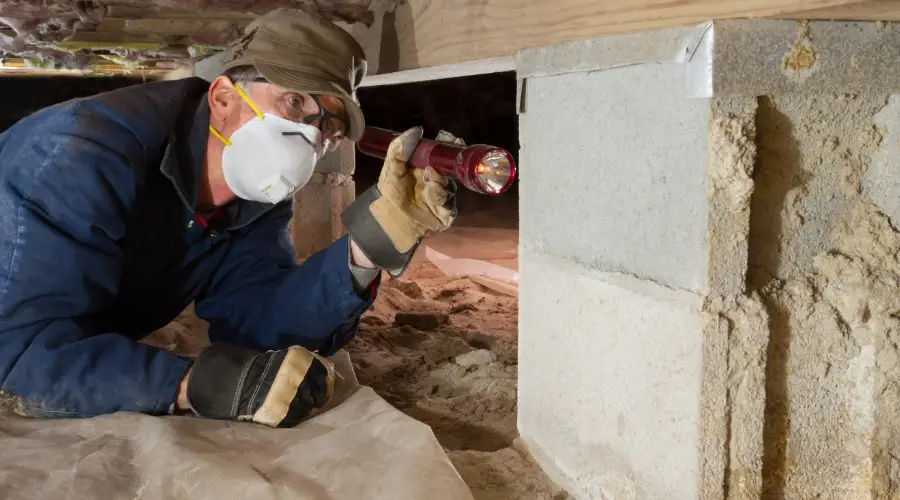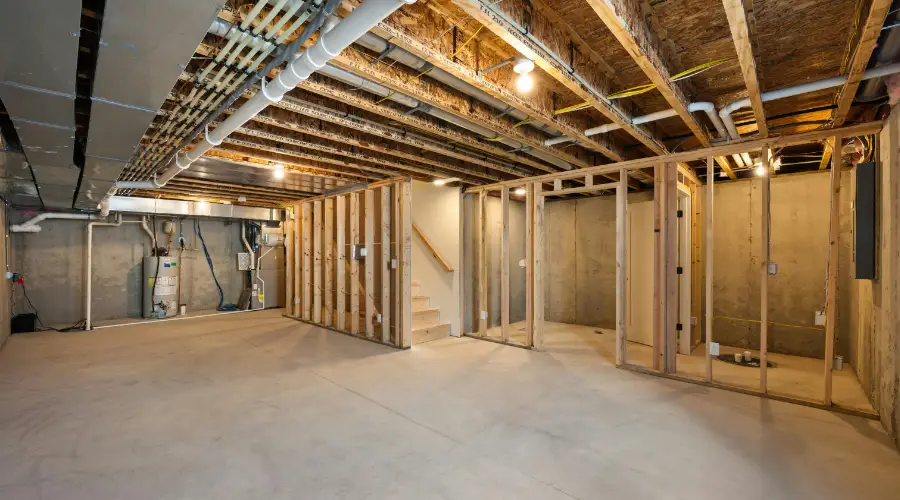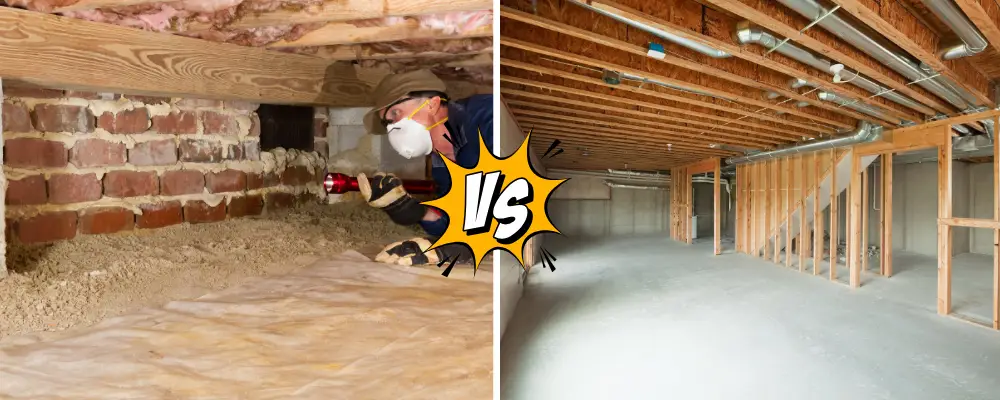One of the most critical elements when building or buying a new house is the foundation. It is a very important part that guarantees the whole structure of the building and the good working of the space below earth level. Usually, the place under ground floors in most houses is either a crawl space or a basement. Both of them have their unique features and the choice between the two can affect the maintenance, value, and the use of the property over a long time. This blog delves into subjects such as the differences between crawl spaces and basements, the pros and cons of each, and the impact that these two have on the whole design and functionality of a home.
What are Crawl Spaces?

The term “crawl space” refers to a shallow and unfinished area below a house, which is the space between the ground (crawl space foundation/earth) and the first floor in most cases. It usually has very limited headroom, is less than three feet in height and therefore one is required to crawl in order to access the space. Houses with this kind of foundation are mostly found in places with a lot of moisture in the air or those that need easy access to the plumbing materials, electrical wiring, and HVAC systems for the purpose of maintenance. Crawl spaces are generally constructed with concrete or dirt floors and are supported by piers or short foundation walls. The main purpose of a crawl space is to elevate the home above the ground level to avoid water damage and allow for maintenance and air circulation, preventing mold and mildew growth.
Elements of a Crawl Space
The essential elements of a crawl space include:
- Foundation Walls: These walls provide the necessary support to the building and act as a barrier to separate the home from the soil. They can be constructed with concrete, block, or stone materials.
- Vapour Barrier: Commonly, a plastic sheet or coating is laid/ applied out over the ground which acts as a barrier to moisture that comes up from the soil. This helps to keep the area dry, which is an indispensable requirement for not only stopping the formation of mold but also for maintaining the quality of air indoors.
- Ventilation: Normally, the crawl space is equipped with vents that allow the air to move in and out of the space. Proper ventilation is particularly important in setting the moisture level and thus, preventing issues like condensation and decay.
- Insulation: An insulated crawl space will be able to help the temperature in the house become more stable. Depending on the requirements of the building, the insulation can be put either on the walls or on the floor.
- Access Points: Typically crawl spaces have a small door or access hatch that allows maintenance or repairs to be done. The hatch must be large enough to allow workers access to perform the tasks.
Crawl Space Types
Different crawl space homes vary in their design and features. These are specially designed to cope with different environmental and building demands. The common ones are:
- Vented Crawl Space: This is the traditional type that depends on vents which allow the air to flow through the space. Though it prevents moisture buildup, air leakage can happen which can make the home less energy efficient.
- Unvented Crawl Space: In contrast to vented spaces, unvented crawl spaces are airtight to avoid any exchange of air with the outside. Hence, the risk of water infiltration is minimised here but insulation and drainage should be done with great care.
- Encapsulated Crawl Space: A space such as this is absolutely sealed and comes with a vapor barrier on the floor and walls. The purpose of this design is to deal with moisture effectively, as well as keep out the pests.
- Conditioned Crawl Space: Essentially, it is a closed and insulated crawl space that can be linked to the home’s HVAC plan for retaining comfortable and even temperatures throughout the year. Generally, this kind of a crawl space is selected for new houses so as to achieve maximum energy efficiency.
What is a Basement?

A basement is a space underneath the surface of a building that generally has a larger ceiling height than a crawl space. Usually, basements are made with walls at full height, thus opening up the area to be a living space that is accessible and usable. In the past, basements were mostly used as storage spaces, but these days basements are also being finished and converted to be functional spaces like extra bedrooms, home theatres, or home offices. Basements are usually built in places that have cold weather or in locations where the water table is low enough that the area does not get flooded. The style and the building of the basement depend on the location and the purpose of the space.
Crawl Spaces vs Basements: What’s the Difference?
The choice between a crawl space and a basement is influenced by different factors such as the weather, the price, and the purpose of the space. Here are the main differences between crawl spaces and basements.
Space and Accessibility
- Crawl Space: Crawl spaces have limited headroom, and therefore the individuals inside have to crawl to move around in the space. They are only good for plumbing and electrical works, and not for creating living spaces.
- Basement: Basements have full or functional heights, so they are more flexible. They can be turned into habitable spaces, thus adding more space and square footage to the house.
Cost
- Crawl Space: Generally, crawl spaces are less expensive to construct than basements. They require less excavation and fewer materials.
- Basement: Basements are more expensive due to the additional excavation and structural support required. They also tend to have higher construction costs because of their potential for being finished as livable spaces.
Moisture and Ventilation
- Crawl Space: Crawl spaces can trap moisture, especially when there is poor ventilation. Without good vapour barriers and insulation, crawl spaces can be a cause for mold growth and musty smells.
- Basement: Basements can also have moisture issues, however, waterproofing a basement is less challenging. With good drainage and sealing, a basement can be dry and usable as a living space.
Energy Efficiency
- Crawl Space: Crawl spaces are generally not insulated well, and they can sometimes lead to losing energy through drafts along with temperature swings. However, closing off crawl spaces completely can help with energy efficiency.
- Basement: Properly insulated basements can produce better energy efficiency. Their location below the ground results in naturally cooler temperatures in summer and warmer temperatures in winter.
Usage
- Crawl Space: Crawl spaces are primarily designed for maintenance actions to access plumbing/wiring. They are not intended to be habitable or usable spaces.
- Basement: Basements have a variety of uses as they can be utilised as parking spaces, storage areas, home offices or rental spaces. They provide additional usable space to the overall home.
Conclusion
There are a variety of things to consider when deciding between a crawl space and basement. You’ll want to think about your climate, your financial budget, and how you would like to utilise the space. A crawl space may be cheap to build and a viable option for houses that have some specific maintenance needs. However, with a home that has a basement, there are more options to provide additional living or storage space. There is much to consider regarding the advantages and disadvantages of both structures. Being familiarised with these differences should help guide your decision when you build your forever home or look for a secondary home to fit your situation.
Frequently Asked Questions (FAQs)
Crawl spaces are suitable for homes that require easy access for plumbing or electrical services. These types of homes must have proper ventilation and require a certain level of maintenance to prevent mold or damage.
It is fundamental that most crawl spaces do not have the proper height for a livable space and also adequate venting. Some places may be feasible for storage or non-livable activities, but this can only be accomplished with encapsulation and better ventilation.
Basements are generally 40-60% more expensive to construct due to the additional excavation, structural reinforcement, and potential for finishing the space into livable areas.
A well-insulated basement tends to be more energy-efficient than a crawl space. Basements are naturally more stable in temperature, whereas crawl spaces are prone to temperature fluctuations and drafts.

